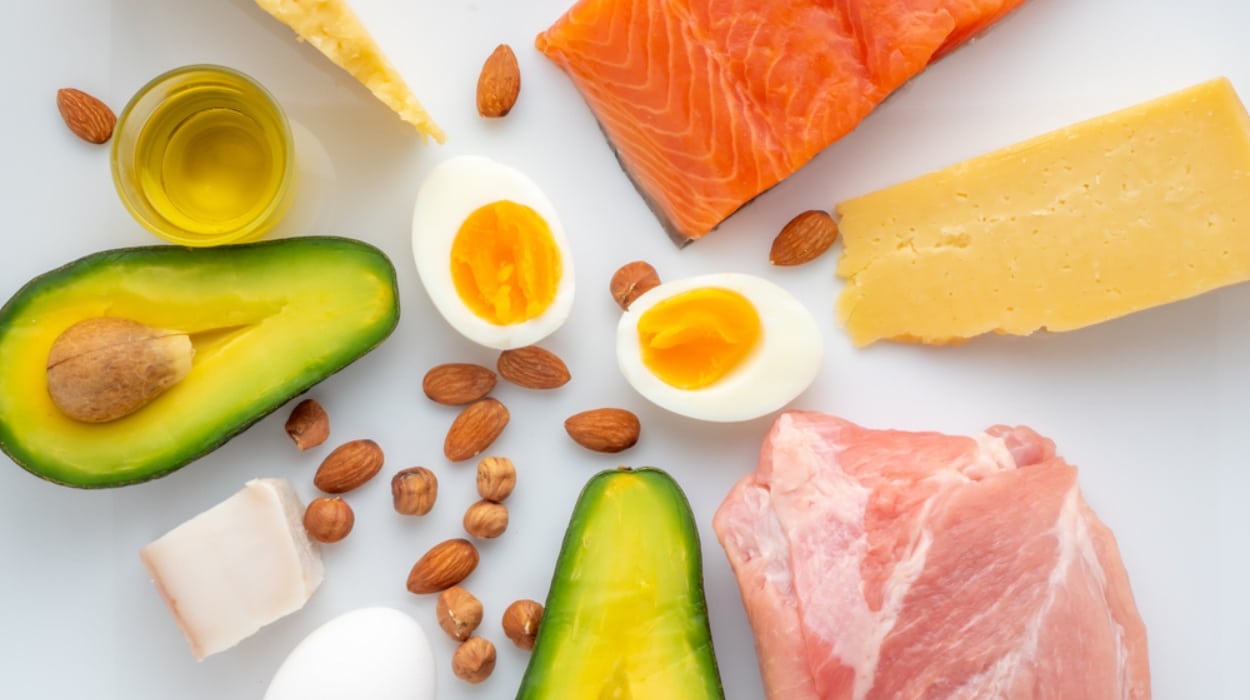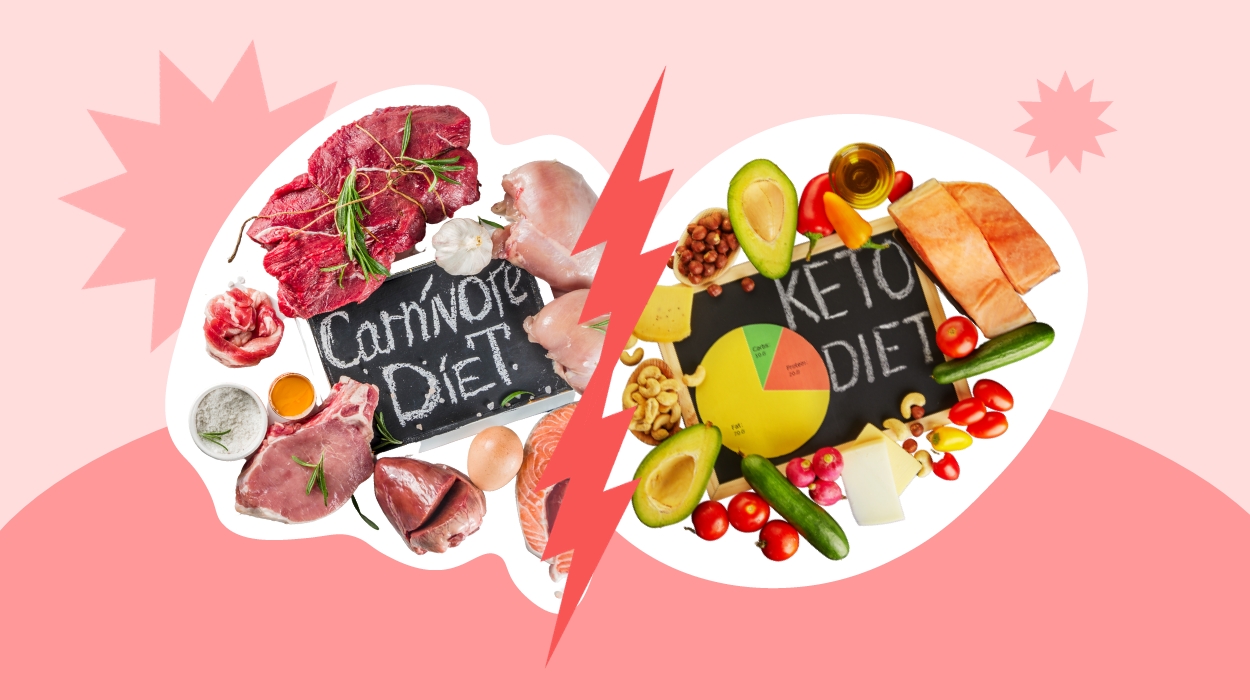Low carbohydrate diets such as the Atkins diet have been popular since the 1970s, and several variations have since emerged. One of the most recent is the carnivore diet, introduced by Shawn Baker, MD, in 2018 in a book of the same name. The diet’s emphasis on red meat and foods like eggs fried in butter has led some to liken the carnivore diet[1] to the ketogenic diet.
While also very low in carbohydrates, the keto diet, introduced decades ago as a way to control seizures in children with epilepsy, places a greater emphasis on fat intake than on protein intake. The result is a diet that, while still very high in meat, emphasizes fats from healthier sources such as nuts, seeds, and avocados. The keto and carnivore diets are, therefore, different.
Carnivore Diet Vs. Keto Diet
The carnivore diet and keto diets are quite different. Both are high in protein and fat and avoid carbohydrate intake, but the carnivore diet is far more restrictive, allowing only meat and products from animals (milk, cheese, etc, …).
The result is a diet that omits important sources of nutrients such as fresh fruit and vegetables. Although, in theory, the diet could be helpful with weight loss and perhaps other health issues, it is probably best avoided.
Carnivore Diet Vs. Keto Diet: A Closer Look

The carnivore diet is a zero-carb diet that includes only animal products. This diet emphasizes protein sources such as chicken, pork, beef, shellfish, and fish. Most proponents of the diet also allow eggs and fat-laden dairy foods such as butter, cheese, and cream.
Black coffee and sea salt are also permitted. No other foods are allowed. There are no vegetables, grains, fruits, or other plant-based foods on the carnivore diet. Even if protein supplements are part of one’s daily diet, the carnivore diet requires they come from beef.
The keto diet is a low-carbohydrate and high-fat diet that includes both animal products and low-carbohydrate plant foods. In addition to meat and dairy, this includes nuts, seeds, oils, green leafy vegetables, fresh fruit, avocados, and dark chocolate. Because of its emphasis on low carbohydrate intake, grains, baked goods, and starchy or sugary foods are not allowed on the keto diet.
Carnivore Diet Vs. Keto: The Similarities

Both Diets Reduce Carbohydrates
Both the carnivores and keto diets limit carbohydrates but the carnivore diet does so entirely. The carnivore diet does not include any plant foods. The keto diet has few, but not zero carbohydrates. The exact keto macronutrient breakdown varies by source, but a typical keto diet consists of roughly 5-10% carbohydrates, 30-35% protein, and 55-60% fat by calories.
Therefore, a man on a 2,500-calorie per day diet will get between 125 and 250 calories from carbohydrates on a keto diet, whereas a normal diet includes around 1,000 calories per day from carbohydrates. In contrast, carbohydrate intake is so restricted on the carnivore diet that the goal is for 0 calories from this food group.
Both Diets Are High In Fat & Protein
Both the carnivore and keto diets are quite high in fat and protein. With both diets, at least 90% of daily calories come from fat and protein. The diets are also similar in that they emphasize fat over protein intake by about a 2:1 ratio. Therefore, they encourage dieters to eat fattier foods such as meat and oily fish. They also allow for a substantial intake of dairy products such as milk and butter.
Keto And Carnivore Diets Both Alter Metabolism
Normally, carbohydrates are the body’s main source of energy. However, as we have seen, both the keto and carnivore diets are very low in carbohydrates. When sugars and starchy foods are limited, the body switches to relying on fat for energy. This process of using fat as fuel is ketosis.
Both the keto and carnivore diets can switch the body into ketosis,[2] which can reduce hunger from a low-calorie diet. When there are few carbs, the liver breaks fatty acids down into ketone bodies, which can be used for energy. These ketone bodies keep the ghrelin hunger hormone under control,[3] even during weight loss, when it normally increases.[4]
Carnivore Diet Vs. Keto Diet: The Differences
A Keto Diet Includes Carbohydrates
The one major difference between these two diets is that the keto diet allows dieters to eat carbohydrates. You can eat nonstarchy vegetables and some fresh fruit which are major sources of important vitamins and minerals.
Since the carnivore diet allows no carbohydrates at all, it becomes important to supplement the diet more than with keto.
A Keto Diet Includes Plants
Keto diets emphasize eating plant foods when possible. In addition to fresh fruit and vegetables, this also includes seeds, tree nuts, and avocados, all of which are excellent sources of healthy fats. This fact is a primary reason why keto diets are generally healthier than the carnivore diet.
A Keto Diet Is Higher In Fiber
By emphasizing the intake of carbohydrates, protein, and fats from plants in addition to animal products, a keto diet allows for higher fiber intake than the carnivore diet. Since fiber is only found in plant foods, the carnivore diet includes no fiber whatsoever.
This is a particularly significant difference given the importance of fiber intake[5] to colon health and even cancer prevention. Moreover, since high intake of red meat, as prescribed by the carnivore diet, has been linked[6] to a higher risk of colon cancer, the diet’s lack of fiber seems to heap insult upon injury.
A Keto Diet Is More Likely To Induce Ketosis
If you are considering a carnivore diet because you want to induce ketosis and force your body to burn fat, there is no guarantee that the diet will do so. While ketosis may result from eating the carnivore diet, it was not designed to induce ketosis like the keto diet was. Therefore, if this particular goal is important to you for weight loss[7] or other goals, stick with keto.
Keto Vs. Carnivore Diet: Which Is Better?
In the final assessment, a keto diet is better for you than a carnivore diet.[8] In virtually every metric of health, keto outperforms carnivore.[9] So if you’re considering choosing one of these two very low-carb diets, keto is the better choice.
While the claims for the carnivore diet, including weight loss, mood support, and blood sugar control, are impressive, there is a lack of hard science backing these claims. Eating the right proportions of micronutrients and supplementing properly to assure sufficient intake of vitamins and minerals, makes a keto diet an excellent way to lose weight.
Conclusion
While they share in common the features of high fat and high protein, the carnivore diet and keto diet differ substantially in other ways. Since the carnivore diet prohibits carb intake, it lacks vitamins and fiber. Health-conscious dieters are better off on a keto diet, which will give them sufficient energy for exercise and avoid the risks associated with increased meat consumption.
Frequently Asked Questions
The carnivore diet is a diet in which a person eats nothing but meat, fish, eggs, and some dairy products. It makes certain unproven health claims.
Although both diets emphasize high fat and protein consumption, the carnivore diet is different in lacking carbs entirely.
The keto diet is undoubtedly the healthier option of the two since carbohydrates, while potentially harmful in large amounts, are nevertheless an essential part of daily eating.
 Expert's opinion
Expert's opinion
